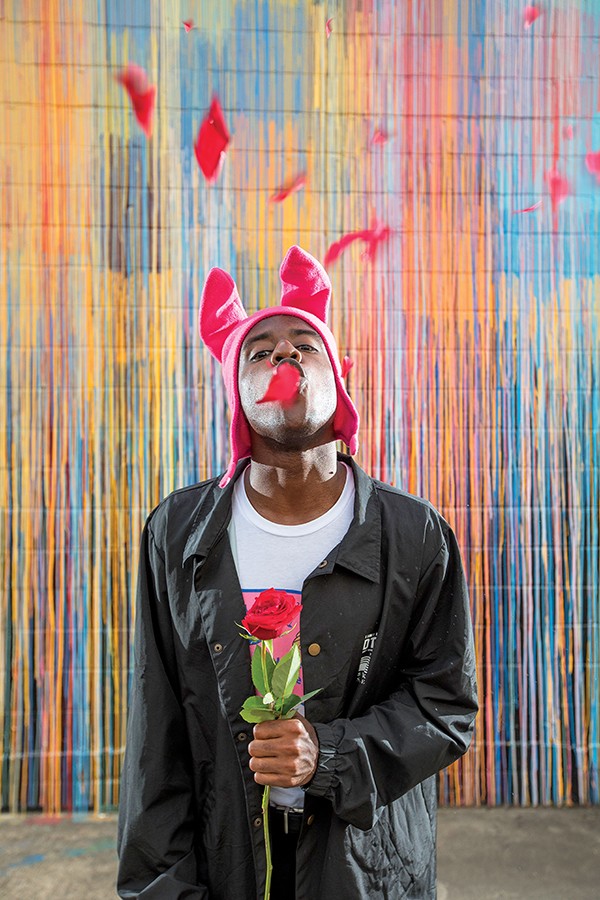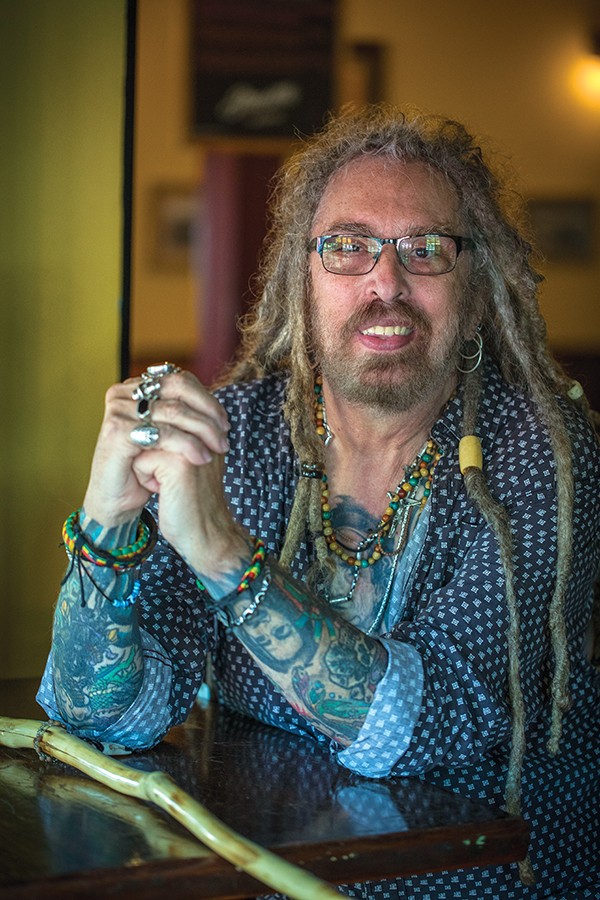Nicole Dorsey and Vaughan Dewar
When you walk into the living room of Nicole Dorsey and Vaughan Dewar’s Midtown home, you’ll find shelves and shelves (and more shelves) of wigs — red ones, blue ones, long ones, spikey ones, curly ones, sleek ones, ones with built-in cat ears, and so on.
But this massive wall of colorful hairdos is not even half of the couple’s unique shared wardrobe.
In all, the two say they have about 100 wigs and 300 costumes: Some they bought, some they had made, some they made themselves, and others that are hand-me-downs.
Dewar says he’s been collecting costumes since his youth, and Dorsey has been making them all her life, she says, recalling all of the Latin convention costume contests she won in grade school. Even back then, she says she went all out. It was just her way of “artistically expressing” herself.
The couple met at a food awareness event about a decade ago, and Dorsey says when they did, it ignited a part of herself that had been dormant for years. Many of their passions overlapped — makeup, books, philosophy, and of course, costuming.
Dewar, who was voted least likely to conform in high school, says he started playing dress-up as young as seven years old, but was terrified and guilt-ridden to do it back then. Now, years later, often going out and about in full drag attire, Dewar has confidently made costuming a part of everyday life.
He’s not alone, though. Dorsey says each morning when she gets dressed for her communications job at Crosstown Arts, she matches that day’s “persona” to the way she feels that particular morning. Usually picking out her wig first, she then tops her look off with an eccentric outfit that fits the theme of the persona, whether that be gothic, zombie, punk, Wonder Woman, or whatever version of herself she feels like portraying that day.
They don’t keep their extensive wardrobe all to themselves either, often hosting parties in their spacious home, which is equipped with a few walk-in costume closets, a stripper pole, and a disco-lit sometimes-dance, sometimes-movie room.
Dewar says the parties are usually filled with their friends exploring and trying on the couple’s hat, wig, and costume collection. “They’re really just props to make everyone more playful,” he says. Dorsey says the parties are social gatherings, but in a way they are also community outreach, as their home has become a safe place where people can come, find fellowship, and be themselves.
“For some reason, our home is that [safe place], and I like that our home is that way,” Dorsey says. “I want everybody to feel like they can totally be themselves when they walk through that door.”
It’s not all fun and games for Dorsey and Dewar, though. The couple also has a shared passion for helping the community. Dewar had been involved in food awareness campaigns for about 10 years before meeting Dorsey, but for now the two focus their attention on prison reform. Additionally, because creativity has been at the core of both their experiences, they feel it is important to support local artists and the theater by donating and attending shows regularly.
“We feel we’re more fulfilled and more real when we can be doing good for others in the community,” Dewar says. — Maya Smith

John McIntire
John McIntire
John McIntire could be the Aquarius poster child. The 82-year-old Memphis artist and retired Memphis College of Art sculpture professor embodies his astrological sign’s traits. He is independent, charitable, and strongly creative.
With his wild shock of hair, mustache, and beard and his affinity for wearing Hawaiian shirts (he owns 500), McIntire fits the role of the eccentric artist. When he’s not landing a great buy at an estate sale or happening upon some fabulous street find or lending a helping hand to friends with food, money, or a place to stay, McIntire is in the backyard at his Midtown home (which he bought at a yard sale) carving one of his abstract marble pieces.
McIntire’s work is in Memphis Brooks Museum of Art, Cranbrook College of Art, and many private collections. His sculpture, The Muse, stands across from City Hall. A statue of Jesus he sculpted as a Christmas gift to Elvis from “Memphis Mafia” members resides at Graceland.
McIntire’s lifestyle is a colorful backdrop to his colorful life. In the 1960s, McIntire owned the Bitter Lemon coffee shop. “The Beatnick Inn” — the apartment he lived in at 2166 Madison — was populated by artists and writers. Beat poet Allen Ginsberg woke McIntire one night to do mantras with him on the banks of the Mississippi River.
Today, McIntire’s yard includes four o’clocks, elephant ears, ferns, and paw paw trees. A large bust (that he didn’t make) of Jesus rests on the porch, along with dishes for cats he feeds.
“Right now, I’m feeding eight,” he says. “Four or five I can hug and pick up and kiss ’em. The rest of them, they’ll take my hand off, even though I’ve known them forever.”
McIntire doesn’t have air conditioning; he gave the unit to a neighbor — along with a washer and dryer. He doesn’t cook. “That stove has never cooked anything in the house. It was given to me. It never did work.”
Born in Wellsville, Ohio, McIntire first displayed his creativity at two, when he painted his crib with his excrement. “My sisters and my mother saw that. I was real happy. I was just standing up in the crib.”
One of 10 children, McIntire, whose father owned a dry cleaning business, didn’t dress like the other school children. “I wore some of the wildest clothes to school. Sometimes teachers would send me home.” Teachers took McIntire out of class to paint theater sets and decorations for school events. His parents displayed his work at the cleaners.
McIntire, who has never worn Levis (that was country kids apparel), also wore un-retrieved men’s suits from the cleaners. “People who came to visit the school thought I was a teacher, because I was six feet tall in grade school. I was the captain of the basketball team.”
His uncle got him started with Hawaiian shirts. “They were beautiful, and I’d wear them. Big belts on the side. And I’d paint my shoes bright colors.”
McIntire doesn’t mind being called a “character.” “I didn’t know I was. But everybody says I was. I don’t care. ‘Cause I stand out.” — Michael Donahue

A Weirdo From Memphis
A Weirdo From Memphis
If you were walking down Madison a few months ago, you might have been treated to the sight of a guy dressed only in boxer shorts and a floppy, pink bunny hat being towed behind a car on a skateboard.
Just another day in Midtown, right?
Not exactly. That guy was A Weirdo From Memphis, a hip-hop artist signed to the Unapologetic label. He was shooting a video for his collaboration with MonoNeon, “America’s Perverted Gentlemen (Drawls).”
In the image-conscious rap game, you can be known as tough, rich, or sexy, but not weird. Rappers are expected to be the coolest guys on the block, but A Weirdo From Memphis (AWFM to his fans) doesn’t care what you expect.
AWFM was always a hip-hop fan. He remembers hanging out at Sam Goody, listening to music he couldn’t afford to buy. “I was the only kid playing hide-and-seek with my headphones on.”
After his mother was the victim of a series of violent muggings, she kept her son indoors. While the other kids were out shooting hoops, “I was inside playing video games all the time. I was an early internet kid, because I wasn’t able to go outside and play with normal kids. … My social media was getting on IRC channels, pen-palling with strangers I would never meet, talking about nerdy game stuff,” he says. “Those days are when I recognized that I was strange and different.”
It wasn’t easy being a young weirdo. “I was heavily bullied,” AWFM says. “People would make fun of me for whatever I did — drawing, I would try to freestyle, I would try to play basketball. I stopped trying to publicly pursue my interests. I stopped drawing, stopped trying to learn to skateboard. It reached a pinnacle in 9th grade.”
After a particularly brutal school year, AWFM got fed up. “I started exploring and taking random risks,” he says. “Then I started to develop early Kanye complex. I was going to get it, whatever it takes. Teachers didn’t like me. They have me blocked on Twitter to this day. Students didn’t like me. I think I got Most Likely to Succeed in high school as a joke. I was obsessive. I didn’t care. But it became a good character strength. Not caring lets you explore the limits of how far you can go.”
The University of Memphis gave him a place to reinvent himself. Always obsessive, when he wasn’t studying for his computer science degree, he was practicing his flow. “I wanted to rap, but I was bullied so much in high school that I didn’t have the confidence to listen to the voice in my head.”
Then, he made a pilgrimage to Columbus, Ohio, for a Tyler the Creator concert. “That show changed my life. Just to see a baseball field full of kids crashing into each other and enjoying the music … All the energy, how influential amazing music can be. I just walked away from that show knowing from then on everything was going to be centered around really doing it.”
AWFM hooked up with Unapologetic Records when producer Kid Maestro caught him performing at Crosstown Arts.”We were looking for someone to push the envelope,” says Maestro, who immediately called Unapologetic CEO IMAKEMADBEATS and said, “I think I found the guy.”
His trademark hat is a tribute to Bunny Boy, a character in Harmony Korine’s exploitation classic Gummo. AWFM first donned it when filming a video for his song “Animals,” and it stuck. “It’s about criticizing human nature. We think we’re a different breed, but we exhibit these animal instincts of selfishness. If you just take away cameras or the spotlight, people will do the expected action, which is to put themselves first.”
AWFM and Kid Maestro have been busy in the studio on an album they expect to release this fall. “People from high school will creep into Unapologetic shows and be like, ‘What in the world happened to you?'” says AWFM.
“I stopped conforming. I was going to do what I wanted to do.” — Chris McCoy

Rod Norwood
Rod Norwood
If you lived in Memphis in the 1990s and loved guitars, you probably knew Rod Norwood as the co-proprietor (with Hank Sable) of Rod & Hank’s Guitars, a legendary music shop located in downtown Memphis.
Rod looked a little different back then, but two bouts with cancer, a heart attack, and an illness-induced bankruptcy will change a fellow’s attitude toward life. In recent years, Norwood has embraced his inner (and outer) Keith Richards — and, in the process, the real Rod Norwood. His dreadlocks flow onto his shoulders and down his back; his rings, bracelets, earrings, and necklaces accent the elaborate tattoos on his arms and chest. (And yes, that is Keith Richards’ face on his chest.) A carved walking stick completes the look.
You may be cool, my friend, but you ain’t Rod Norwood cool.
Norwood delights in the reactions — good and bad — his appearance provokes. If you don’t like it, well, too damn bad. “I’ve had cancer twice,” he says. “I still have cancer. I got rid of the stomach cancer, but the chemo really fucked me up. I can barely walk, I’ve got neuropathy so bad. It screwed up my heart. Then I had a heart attack. And then, once got I through that, I found out I had prostate cancer. It’s been a struggle for me and [wife] Reda. We took a fall from grace, but we kinda landed on our feet, with the help of friends and the fact that I got on disability.”
Norwood grew up in Cooper-Young, where he still lives. “I never really left,” he says, “except for traveling the world in the guitar business. I’ve seen the neighborhood go from working class to low-rent and now back to where it is now.
“When I was a kid,” he says, “I didn’t hear any racism from my parents, so I couldn’t stand the redneck kind of stuff I heard at school and around town. I didn’t fit in real well with the attitudes in Memphis at the time.”
The 1960s changed things for Norwood. He embraced the hippie ethos. “My wife and I were into vintage stuff. We only wore vintage clothes. We never passed a pawn shop by.” He worked as a meter reader for MLGW for 14 years, but soon found himself making more money buying and selling guitars and jumped into the business full-time in the 1990s.
Nowadays, Norwood’s claim to fame (aside from his stellar look) is his Facebook posts, which are legend among a growing group of fans. He has a hilarious long-running mock feud with Memphis musician Steve Selvidge, and he offers opinions and anecdotes on a variety of topics. He describes his writing as a combination of National Lampoon and Hunter Thompson. “Basically,” he says, “It’s the way I view the world. I’m just trying to make somebody laugh.” Here’s a sample post:
Hey, this really happened the other day. A strikingly attractive couple stopped me on the street to ask about my dreadlocks, they were very sweet, innocent to a fault. The girl asked if she could touch my dreads. “Certainly,” I said, “Touch them, touch them with your hand.” I put heavy emphasis on the word “hand,” saying it with lust, depravity, and an almost despicable, yet desperately sad longing. Longing for what, I can’t say. It queered the deal; they grew frightened and fearful. I flashed a Bogart smile, all teeth — at that point the situation fragmented, the girl began to weep softly, the young man, adopted a fighting stance. Sometimes it just doesn’t pay to be nice to people.
Maybe so, but the truth is you’ll seldom meet a nicer guy than Rod Norwood.
— Bruce VanWyngarden

Odd Wilson
Odd Wilson
Odd is odd, and he’s been called that his whole life. “I’ve always been kind of the oddball,” says Wilson. “I’ve been the introvert, and I stay to myself and stay out of the way. People look at me and they think, ‘He’s a weirdo. There’s something not right with him.’ I guess it’s because I don’t move like everybody else does or do what everybody else does. I stay in my own lane.”
Odd Wilson is his stage name as a musician, but it’s the name he wants to go by.
“People didn’t understand me, especially in the urban community,” Odd says. “Everybody was wearing tight pants or baggy pants. I dressed like a skateboarder and listened to Nirvana in my headphones. A lot of people didn’t understand it. So, I distanced myself from what everybody else had done.”
Advice from his mother back then left Odd to believe that that was just fine, even though he had a hard time fitting in. But Odd just keep on being Odd. Thanks to that, tracks from his upcoming album, Welcome to Oddville, will likely be some of the most original you’ll hear from a Memphis musician this year.
The 30-year-old says he’s been an independent music producer, working with various musicians at Ardent Studios, Young Avenue Sound, and others. But artistic frustration led him to step out and to do his own thing.
That thing is a texture of layered instruments resting on pulsing drum tracks, which Odd says is like “hip-hop fused with [electronic dance music] a little bit.” The track on his website, for example, is called “Slow Burn,” and it’s certainly that.
The pondering, mid-tempo instrumental pulls along methodically under a drum track, almost like a chilled-out R2-D2 at karaoke. But that all breaks apart mid-song to unveil an expansive horn line right out of a 1960s spy show. It has the flavor of Medeski Martin & Wood’s Combustication era.
But Odd says he originally pulled his inspiration from DJ Shadow, who “fused a lot of music together and made his own sound.” Recently, though, Odd’s a fan of Seattle-based, hip-hop/EDM duo Odesza, whose music is certainly made and recorded digitally but is performed live on stage.
“That’s what I want,” Odd says. “That’s what I want to do.”
If you ever see Odd perform, chances are you may not see his face. Instead, you may see only the over-sized, papier-mâché mask of Odd Wilson, the character. “[I made the mask] last year when I was in a real deep depression and had kind of given up on music,” Odd says. “I didn’t want to do it.”
But then he saw Frank, a movie in which Michael Fassbender plays an eccentric band leader who wears a large, papier-mâché mask. To Odd, the movie was less about music and more about dealing with mental illness. He loved the notion and decided to “be the black version of what he’s doing.”
Odd’s newest record, Welcome to Oddville, was slated for a July release but won’t likely be available until August.
“Hey, man, look, when you’re creating music, sometimes you go in directions that you probably didn’t think you were going to go,” Odd says. “Then, you change stuff.”
Watch for the record at Odd’s website, whereoddwilson.com, or follow him on Facebook or Instagram.
— Toby Sells




